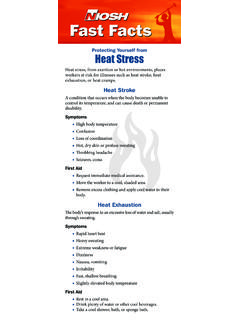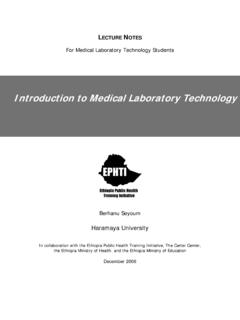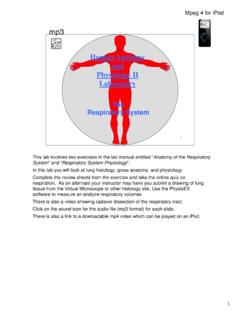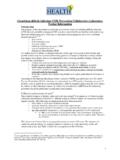Transcription of School Chemistry Laboratory Safety Guide
1 SAFE LAB. School Chemistry Laboratory Safety Guide Department of Health and Human Services Consumer Product centers for disease control and prevention Safety Commission National Institute for Occupational Safety and Health The views or opinions expressed in this Safety Guide do not necessarily represent the views of the Commission. School Chemistry Laboratory Safety Guide October 2006. Consumer Safety Product Commission DEPARTMENT OF HEALTH AND HUMAN SERVICES. centers for disease control and prevention National Institute for Occupational Safety and Health This document is in the public domain and may be freely copied or reprinted. Disclaimer Mention of the name of any company or product does not constitute endorsement by the Consumer Product Safety Commission (CPSC) and the National Institute for Occupational Safety and Health (NIOSH).
2 In addition, citations to Web sites do not constitute CPSC and NIOSH en- dorsement of the sponsoring organizations or their programs or products. Furthermore, CPSC and NIOSH are not responsible for the content of these Web sites. Ordering Information CPSC. Access through the Internet This Guide along with other CPSC news releases, Public Calendar and other information can be obtained via the Internet from the agency's Web site at [For ordering hard copies of publications and publications: Please allow 3 4 weeks for delivery.]. or write to Consumer Product Safety Commission 4330 East West Highway Bethesda, MD 20814. CPSC Consumer Hotline English/Spanish: 1 800 638 2772. Hearing/Speech Impaired: 1 800 638 8270. CPSC Publication No. 390. NIOSH. To receive documents or other information about occupational Safety and health topics, contact NIOSH at: NIOSH Publications Dissemination 4676 Columbia Parkway Cincinnati, OH 45226 1998.
3 Telephone: 1 800 35 NIOSH (1 800 356 4674). Fax: 513 533 8573. E-mail: or visit the NIOSH Web site at DHHS (NIOSH) Publication No. 2007 107. | ii Pull-Outs The following pages are available at the end of the document for easy copying for distribution or posting: Safety Do's and Don'ts for Students How Should Chemicals Be Stored? Suggested Shelf Storage Pattern iii |. Foreword In 1984, the Council of State Science Supervisors, in association with the Consum- er Product Safety Commission and the National Institute for Occupational Safety and Health, published the Safety Guide School Science Laboratories: A Guide to Some Hazard- ous Substances to help science teachers identify hazardous substances that may be used in School laboratories and provide an inventory of these substances. Because School science curricula have changed since then, the Safety Guide has been updated and revised to reflect those changes.
4 This Guide on Safety in the Chemistry labo- ratory was also written to provide high School Chemistry teachers with an easy-to-read reference to create a safe learning environment in the Laboratory for their students. The document attempts to provide teachers, and ultimately their students, with informa- tion so that they can take the appropriate precautionary actions in order to prevent or minimize hazards, harmful exposures, and injuries in the Laboratory . The Guide presents information about ordering, using, storing, and maintaining chemi- cals in the high School Laboratory . The Guide also provides information about chemical waste, Safety and emergency equipment, assessing chemical hazards, common Safety symbols and signs, and fundamental resources relating to chemical Safety , such as Mate- rial Safety Data Sheets and Chemical Hygiene Plans, to help create a safe environment for learning.
5 In addition, checklists are provided for both teachers and students that highlight important information for working in the Laboratory and identify hazards and safe work procedures. This Guide is not intended to address all Safety issues, but rather to provide basic infor- mation about important components of Safety in the Chemistry Laboratory and to serve as a resource to locate further information. Nancy A. Nord John Howard, Acting Chairman, Consumer Director, National Institute for Occupational Product Safety Commission Safety and Health centers for disease control and prevention | iv Contents Disclaimer .. ii Foreward .. v Acknowledgments .. viii Introduction .. 1. What are the Teacher's Responsibilities? .. 3. What are the Safety Do's and Don'ts for Students? .. 6. What is a Chemical Hygiene Plan? .. 10. What is a Material Safety Data Sheet?
6 12. What Should be Considered When Purchasing Chemicals? .. 13. What is a Chemical Tracking System and How Should It be Set Up? .. 15. How Should Chemical Containers be Labeled? .. 17. How Should Chemicals be Stored? .. 19. Suggested Shelf Storage Pattern .. 21. Suggested Shelf Storage Pattern for Inorganics .. 22. Suggested Shelf Storage Pattern for Organics .. 23. How Should Compressed Gas Cylinders be Stored, Maintained, and Handled? .. 24. What are Some Strategies to Reduce the Amount and/or Toxicity of Chemical Waste Generated in the Laboratory ? .. 26. What is the Recommended Procedure for Chemical Disposal? .. 28. Appendices A. Common Safety Symbols .. 30. B. National Fire Protection Association Hazard Labels .. 31. C. Substances with Greater Hazardous Nature Than Educational Utility .. 33. D. Substances with a Hazardous Nature, But May Have Potential Educational Utility.
7 40. E. Incompatible Chemicals .. 44. F. Recommended Safety and Emergency Equipment for the Laboratory .. 47. G. How Does a Chemical Enter the Body? .. 48. H. What are Exposure Limits? .. 50. I. General Guidelines to Follow in the Event of a Chemical Accident or Spill .. 52. J. Understanding an MSDS .. 54. K. Sample MSDS .. 56. L. Web Site Resources .. 63. M. Glossary .. 65. Pull-outs .. 72. |. Acknowledgments This Safety Guide was written, revised, and reviewed by scientists from the Consumer Product Safety Commission (CPSC), the National Institute for Occupational Safety and Health (NIOSH), and Environmental Protection Agency (EPA). Kailash Gupta, DVM, , Directorate for Health Sciences, served as the CPSC project officer; Patri- cia Brundage, , Directorate for Health Sciences, CPSC served as author, and John Palassis, CIH, CSP, CHMM, Education and Information Division, NIOSH served as the project officer and a co-author.
8 Lori Saltzman, MS, Mary Ann Danello, PhD, from the Directorate for Health Sciences, CPSC, Charles Geraci, , TJ Lentz, , Ralph Zumwalde, Alan Weinrich, Michael Ottlinger, , from the NIOSH Education and Information Division, from the Office Of Director, NIOSH, provided critical review and input. Staff in the Office of Public Affairs at CPSC provided editorial, design and production assistance. In NIOSH, Susan Afanuh provided editorial services, and Vanessa Becks and Gino Fazio provided desktop design and production assistance. The Safety Guide was reviewed with the assistance of American Chemical Society, the National Institute of Environmental Health Sciences/National Institute of Health, the Council of State Science Supervisors, American Federation of Teachers/AFL-CIO, Cin- cinnati Federation of Teachers, National Science Teachers Association, Environmen- tal Protection Agency, Federal OSHA Directorate of Standards and Guidance, Federal OSHA, Region VII.
9 | vi Introduction Recognition of Laboratory Safety and health problems has crystallized since the passage of the Occupational Safety and Health Act of 1970. This Act requires that certain precautions be observed to protect the Safety and health of em- ployees on the job. The employee designation includes all teachers employed by private and public School systems in States that have occupational Safety and health plans accepted by the Occupational Safety and Health Administration (OSHA) of the Department of Labor (DOL). OSHA rules and regulations are provided to protect the employees and the facilities. The importance of Laboratory Safety has been recognized for many years in in- dustry. However, educational institutions have been slower to adopt such Safety practices and programs. A science program has certain potential dangers. Yet, with careful planning, most dangers can be avoided in an activity-oriented science program.
10 It is es- sential for all involved in the science instruction program to develop a positive approach to a safe and healthful environment in the Laboratory . Safety and the enforcement of Safety regulations and laws in the science classroom and labora- tory are the responsibility of the principal, teacher, and student each assum- ing his/her share. Safety and health should be an integral part of the planning, preparation, and implementation of any science program. The Importance of Safety Safety and health considerations are as important as any other materials taught in high School science curricula. Occupational injury data from industry studies indicate that the injury rate is highest during the initial period of employment and decreases with experience. Similarly, in a high School Laboratory setting where stu- dents experience new activities, the likelihood of incidents, injury, and damage is high.















